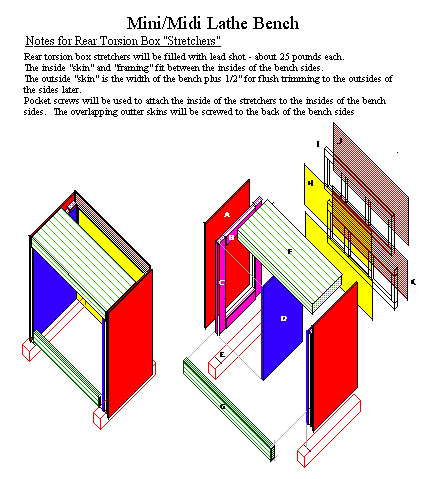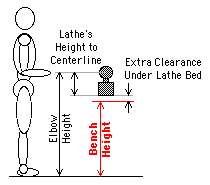Das Lathe Bench
(What follows illustrates my approach to designing and building things - start out with the basics of the thing you're going to make then build and adapt as you go. In each project, try a new technique, or two, or three - a type of joint you haven't tried, a type of wood you haven't worked with before, a finishing method you've heard about that sounds interesting. And DON"T GET HUNG UP ON TAPE MEASURE measurements. What's important is that things fit together properly, not how long a piece is - in inches and fractions of inches - down to 1/32nds - or 1/64ths if you're really anal retentive. If all the parts that are supposed to be the same length are cut to the same length and fit where they're suppose to, it doesn't matter if they're 1/8th of an inch or so longer or shorter than on THE PLANS.
If you Build as You Go and "measure" directly from what you've got right now, you'll be fine. If somethng has to fit between two parts you've already put together, preferably dry fit, use two sticks and a spring clamp to hold them together. Slide the sticks 'til they fit where they're suppose to go, clamp the sticks together and head over to the chop saw/miter saw. Put one end of your sticks agains the blade, set a stop to the other end and cut your parts. They will fit, without "tape measuring" anything.
Das Lathe Bench, like so many other projects, started out to be a quick and dirty / slam together place to temporatily /permantly get the JET mini/midi lathe off my real work bench, and all the stuff associated with it. A 4x12 header remnant about 40 inches long for the top, some 2x4s for uprights, sheathed in ply, for the sides, two more 2x4s for stetchers and redwood fence post 4x4s for the sled legs. Some glue, some pocket screws -bah-dah-bing - it’s done!

BUT FIRST - how tall and how deep?
Apparently the “how tall” is determined by your elbow height when standing upright. That is the height of the centers of the lathe. Makes sense -you want the lathe gouge or chisel tip to be on or above the centerline of the piece your turning, the end of the handle AT or BELOW the lathe centerline, NEVER ABOVE.
So if I measure the distance from the lathe centerline to the bench and subtract that from my elbow height, the results will be my bench top height right?
Answer: Maybe.
What?
Let’s back up a minute and think about how I work. I’m going to be using several gouges and chisels - a roughing gouge, spindle or detail gouge, parting tool and maybe a skew. Where am I going to put the ones I’m not using right now? Why under the lathe bed more than likely.
Anything under the bed that I can hit with that nice sharp edge I spent some time creating?
I’ve got the JET VS mini/midi lathe. The motor is directly under the lathe bed, leaving about an inch between the bottom of its housing and the bench top. Hmmm - maybe I should raise the lathe to get more clearance - say an inch and a half or better yet - two inches.
So now I’ve got
Elbow Height
minus
Lathe’s bottom of base to center line height
minus
An inch and a half for clearance under the motor
equals
Bench Top Height

Now I've got the MINIMUM height to the bench top. An extra inch or so might be wise - there's going to be a rubber mat in front of this thing - concrete floors are hard. AND - it's far easier to raise ME UP than it is to LOWER THE BENCH (see reference to concrete floor).